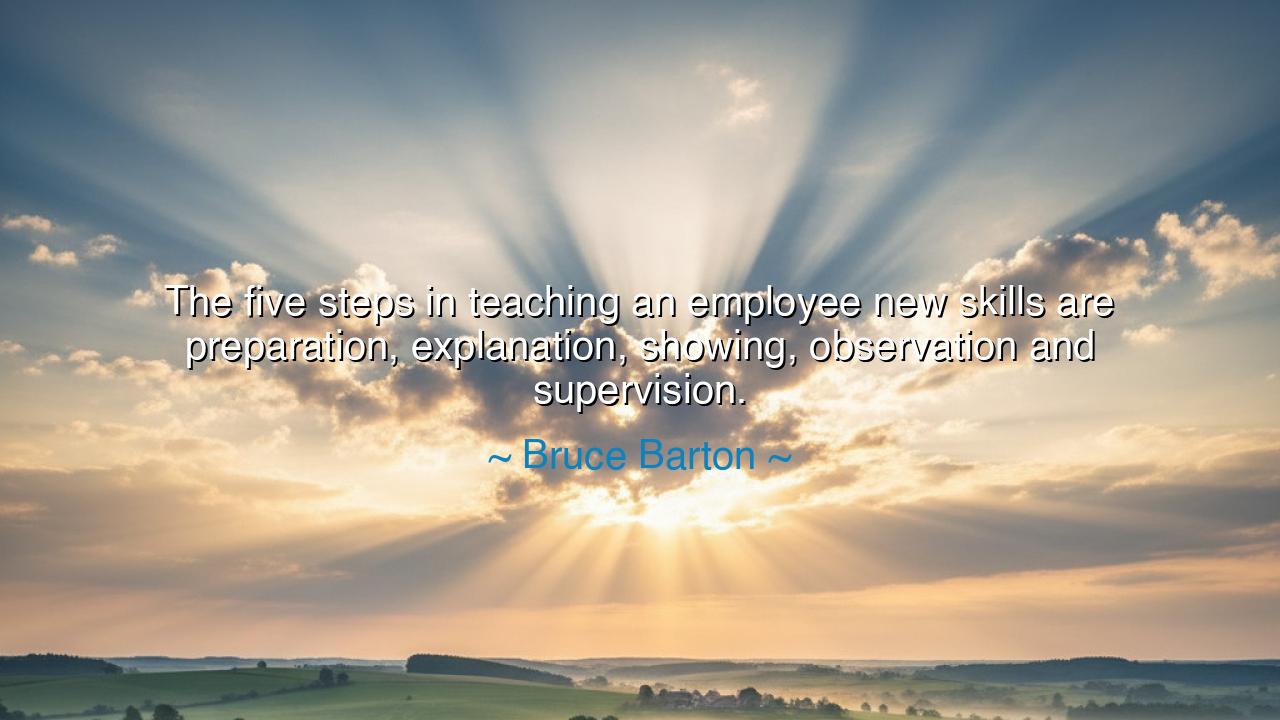
The five steps in teaching an employee new skills are
The five steps in teaching an employee new skills are preparation, explanation, showing, observation and supervision.






Hear the words of Bruce Barton, a master of industry and wisdom, who declared: “The five steps in teaching an employee new skills are preparation, explanation, showing, observation, and supervision.” This saying, though spoken in the halls of business, carries the same truth that guided the training of warriors, the discipline of craftsmen, and the teaching of philosophers since the dawn of time. For every skill, whether of hand or of spirit, requires order, patience, and guidance. Barton did not simply list methods—he revealed a path, a sacred sequence by which raw potential is shaped into mastery.
The first step is preparation. Without it, nothing can be built. As the farmer prepares the soil before the seed, so must a teacher prepare the mind before the lesson. The student must be made ready—mentally alert, emotionally willing, practically equipped. A soldier without armor cannot stand in battle, and a worker without preparation cannot stand in labor. To prepare is to awaken expectation and lay the foundation upon which skill will rest.
Next comes explanation. Words, clear and ordered, are the lamps that light the mind. Explanation gives the “why” and “how” of the task, so that the student does not stumble in darkness. Yet, as Barton knew, words alone are not enough. They are like a map to a traveler—necessary, but incomplete without the journey itself. Explanation gives direction, but it does not yet give life.
Therefore follows showing. The wise teacher does not command from afar but demonstrates with his own hands. The craftsman shows the apprentice how the tool is held, how the strike is made, how the detail is shaped. The warrior shows the recruit how to hold the shield and wield the sword. Even the saints of old showed their followers not only their teachings but their lives. For without the living example, words risk becoming empty echoes. Showing is proof, the embodiment of the lesson.
After this comes observation. Here the student begins to act, and the teacher steps back to watch. Just as a parent sees the child take its first steps, the mentor observes the worker attempt the new skill. Mistakes are made, yet each error is a stepping-stone. The teacher must watch closely, not to condemn, but to understand—so that correction may be wise and encouragement timely. In observation, the teacher learns as well: he sees where the student struggles and where he shines.
Finally, there is supervision. For no skill is mastered in a single attempt. The student must practice under the watchful eye of the mentor until confidence is forged and precision is gained. Just as an eagle hovers over its young until they can fly without falling, so must the guide remain until the worker is strong enough to labor alone. Supervision is the patient guardianship that ensures success is not an accident, but a habit.
The lesson in Barton’s words is not for the workplace alone, but for all of life. Whether we teach a child to speak, a friend to endure hardship, or a community to live justly, the same five steps hold true. We must prepare hearts, explain with wisdom, show with our example, observe with care, and supervise with patience. In this way, we shape not only skills, but character, loyalty, and strength.
So what, then, are the practical actions? When you teach, do not rush. Follow the sacred order. First, create readiness. Then explain with clarity. Show by example. Step back and observe with a discerning eye. And finally, walk beside the learner until he can walk alone. For by these steps, empires have been built, armies trained, and generations uplifted. And if you would pass down your wisdom in a way that endures, remember Barton’s teaching: mastery is not born in a moment, but forged through preparation, explanation, showing, observation, and supervision.






AAdministratorAdministrator
Welcome, honored guests. Please leave a comment, we will respond soon